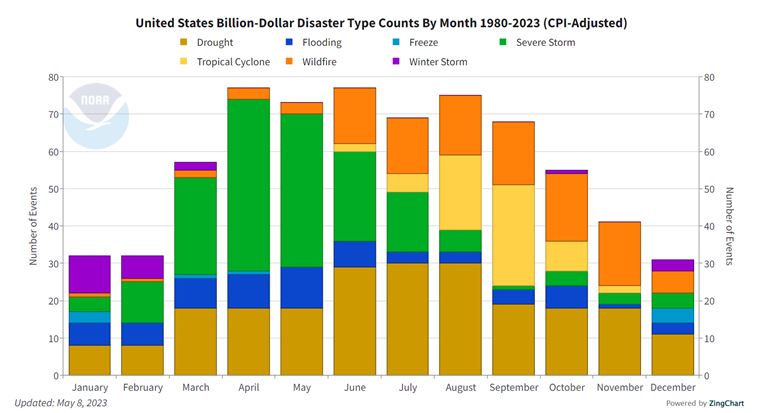The advent of hurricane season each year (June – November) reminds organizations operating in U.S. coastal regions that having a comprehensive resiliency plan is no longer an option. Increasingly, meteorologists are predicting more frequent and more dangerous storms, challenging traditional concepts of disaster recovery.

Source: NOAA National Centers for Environmental Information (NCEI) U.S. Billion-Dollar Weather and Climate Disasters (2023).
During the fall season, Gulf and Atlantic coast states must be vigilant about hurricane season particularly during August and September (i.e., yellow events in chart above). Hurricanes are the most destructive and costly of these events totaling damage losses exceeding $1 trillion since 1980. Organizations must take proactive measures to safeguard their operations, employees and assets. With the increasing frequency and intensity of hurricanes, it is crucial for companies to refresh their business continuity programs and associated plans. By doing so, organizations can minimize downtime, maintain customer confidence and provide quicker recovery from the aftermath of these devastating natural disasters.
Understanding the impact of hurricanes on businesses
Hurricanes can wreak havoc on businesses in various ways. Strong winds, heavy rainfall, storm surges and power outages can disrupt supply chains, damage infrastructure and compromise the safety of employees and customers. The economic consequences can be significant, with potential losses in revenue, productivity and customer trust. As this earlier blog explained, organizations will need to reevaluate business continuity programs to ensure their hurricane preparedness activities are applicable as follows:
- Personnel risk as part of business resumption planning: Companies that have used layoffs and furloughs to reduce costs may see a higher number of single points of failure related to personnel within and among their teams. Teams should self-evaluate in terms of succession, including confirming that cross-trained personnel are available to step in and resume operations in case of sudden unavailability of team members. Businesses should also confirm and leverage the level of assistance that could be offered by supporting operations in a different region or office with little notice.
- Potential IT disruptions: Given that many employees are working remotely, reliance on internet and electrical power remains high, but the variable of a decentralized workforce will add to the potential impact for business operations. It is recommended that leadership review IT disaster recovery plans and IT aspects of crisis management planning to ensure that documentation is up to date and accurate and that team members understand their roles and responsibilities.
- Communication could be limited: The top challenge in any significant emergency or outage event is communicating with employees, customers and other key stakeholders. Effective communication is critical to any crisis management response plan. Yet time and again we see companies fall short in this area. Firms are often using “blast communication” technologies to reach out to their workforce digitally, some post updates only on their website, while others rely on the low-tech “call tree” approach to reach critical personnel. Regardless of the technology or methodology employed, the key struggle for many companies is to communicate meaningful updates in a timely manner.
Eight planning activities for an active season
- Risk assessment and vulnerability analysis: Companies must conduct a comprehensive risk assessment and vulnerability analysis to identify potential areas of weakness. This includes assessing the physical vulnerability of facilities, evaluating supply chain dependencies and identifying critical business functions and assets that require protection.
- Emergency response team: Establishing an emergency response team is crucial for effective disaster management. This team should consist of individuals from various departments, including operations, human resources, IT and communications, who can coordinate efforts and make critical decisions during and after a hurricane.
- Communication plan: Having a robust communication plan is vital for ensuring that employees, customers and stakeholders receive timely and accurate information during a crisis. This plan should outline primary and backup communication channels, designate spokespersons and provide guidelines for internal and external communication.
- Employee safety: The safety and well-being of employees should be the top priority for any organization. Companies should develop evacuation plans, establish emergency shelters and provide adequate training on hurricane preparedness. Regular drills and exercises can help ensure employees are familiar with emergency procedures.
- Data backup and recovery: Backing up critical data and establishing a reliable recovery system are essential for minimizing data loss and downtime. Cloud-based solutions can be particularly beneficial, as they provide remote accessibility and redundancy. Regular testing of backup systems is crucial to ensure their effectiveness.
- Supply chain resilience: Assessing and strengthening supply chain resilience is vital to mitigate disruptions caused by hurricanes. Companies should identify alternative suppliers, establish relationships with backup vendors and implement contingency plans for logistics, transportation and inventory management.
- Insurance coverage: Reviewing insurance coverage is essential to ensure adequate protection against hurricane-related losses. Businesses should work closely with their insurance providers to understand their coverage, update policies if necessary and verify that they have sufficient coverage for property damage, business interruption and liability.
- Post-disaster recovery: Developing a clear roadmap for post-disaster recovery is crucial. This includes conducting damage assessments, initiating cleanup and repair efforts and implementing measures to resume operations as quickly as possible. Collaboration with local authorities and community organizations can help expedite recovery efforts.
Additional questions for leadership to consider
Before the hurricane:
- Are our business continuity plans up to date and adequately prepared for the potential impact of a hurricane?
- Have we conducted a thorough review of our insurance coverage to ensure we are adequately protected against potential losses?
- Are our employees well-trained on emergency procedures, evacuation routes and safety protocols?
- Have we established clear lines of communication with employees, customers, suppliers and stakeholders, including backup communication channels?
- Have we identified critical business functions and assets that require additional protection or backup measures?
During the hurricane:
- Are our employees safe and accounted for? How can we ensure their well-being during the storm?
- Are our communication channels functioning effectively? How can we keep our employees, customers and stakeholders informed in real-time?
- How can we monitor the storm’s progress and receive timely updates from local authorities to inform our decision-making?
- Are there any immediate steps we need to take to protect our facilities, equipment and critical infrastructure?
- How can we support our employees who may be personally affected by the hurricane?
After the hurricane:
- Have we conducted a thorough assessment of the damage to our facilities, equipment and infrastructure?
- How quickly can we initiate cleanup and repair efforts to resume operations?
- Are there any alternative locations or facilities that can be utilized while repairs are being made?
- How can we communicate with customers, suppliers and stakeholders about our recovery efforts and any potential delays or disruptions?
- What lessons have we learned from this experience, and how can we incorporate those lessons into our future business continuity plans?
With hurricane season posing a constant threat to businesses in vulnerable regions, proactive preparation is paramount. Refreshing business continuity programs and associated plans enable companies to navigate the challenges of natural disasters more effectively. In a world where resilience is key, investing time and resources in hurricane preparedness is a wise decision for any business. No one can predict when the next disaster or business disruption will strike; the only certainty is that something unplanned and disruptive will happen— and the time to prepare is now.
To learn more about business continuity and resiliency, download Protiviti’s Guide to Business Continuity Management FAQs, where we answer critical questions along with many other pressing questions about business continuity management and related practices. The guide contains more than 50 questions and answers as well as industry perspectives. Or, contact us.
Read the results of our Global Technology Executive Survey: The Innovation vs. Technical Debt Tug-of-War.






